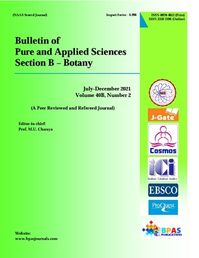The Cyto-morphological Studies in Physalis minima Linn.
DOI:
https://doi.org/10.48165/Keywords:
Cytomorphology, Physalis, Gametic, SterilityAbstract
Cyto-morphological studies in a diploid natural population of Physalis minima Linn were done. It was a diploid natural population recorded behind Jal Mandir on Parasnath hills. Qualitative and quantitative parameters were investigated. Ten morphological characters like height of the plant, number of branches per plant, number of branches from main stem, number of nodes, length of internodes, number of heads per plant, length of leaf, breadth of leaf, length/breadth ratio of leaf andlength of petiole were recorded and statistically analyzed. Cytologically, the population showed, gametic number as n= 12. Most of the pollen mother cells were found to be normal; however, some abnormalities were also recorded. Clumping of chromosomes recorded in both meiotic phases i,e. metaphase-I and anaphase-I. Along with it, at metaphase-I, the anomalies recorded as formation of univalents, multivalents and precocious separation of chromosomes. Anaphase-I showed chromosomal laggards, simple chromosomal bridges and unequal separation of chromosomes as anomalies. The half chiasma per chromosome was 0.87. Pollen sterility was 6.00 percentages.
Downloads
References
Bhaduri, P.N., (1951). Interrelationship of non-tuberiferous species of Solanum with some consideration on the origin of Brinjal, Ind. J. Genet and Pl. Breed. 11,75- 82
Celarier, R.P., (1956): Tertiary butyl alcohol dehydration of chromosome smear. Stain Tech. 31, 155-157.
Chothani, Daya L. and Vaghsiya, H (2012). A phyto-pharmacological overview on Physalis minima Linn. Indian Journal of Natural Products and Resources 3 (4), 477- 482
Choudhary, R.K. and Sinha, A.K. (1990). Cytogenetical investigation in a population of Solanum surattenseBurm F. Recent Researches in Ecology, environment and pollution, Vol. 5: 383-
Today and Tomorrow’s Printers and Publishers, New Delhi-5 (India).
Ganapathi A., Sudhakaran, S., Kulothungan, S. (1991). The diploid taxon in Indian natural populations of Physalis L. and its taxonomic significance. Cytologia, 56, 283-288
Gansau, Jualang Physalins (2001). (13,14- Seco-16,-24-Cyclosteroids) Production in Physalis minima Linn. Malaysia.
Khan, M. A., Khan. H., Khan, S., Mahmood, T., Khan, P. M., Jabar, A (2009). Anti- inflammatory, analgesic and antipyretic activities of Physalis minima Linn. Journal of Enzyme Inhibition and Medicinal Chemistry. 24(3), 632-663.
Parmar, C., and Kaushal, M. K.(1982).Physalis minima p.62-65, In Wild Fruits, Kalyani Publishers. New Delhi, India.
Sharma, N., Bano, A., Dhaliwal, H.S. and Sharma, V. (2015). Perspectives and possibilities of Indian species of Genus Physalis (L) – A comprehensive review. European journal of Pharmaceutical and medical research, 2 (2), 326-353.
Sinha, Kumari Renu, Binod Kumar and A.K. Sinha (2019). Cytological studies in Nicotiana plumbaginifolia Viv. Int. J. Mendel, 35 (1-2), 2018 & 36 (1-2), 2019.
Sinha, P., (2017). Meiotic studies in two populations of Solanum sisymbrifolium Lam. Int. J. Mendel, 34 (1-2), 73-78.
Srivastava, K. and Tripathi, S.N., (1988): Cytomorphological studies in Atylosialineata, Atylosiacajanifoliaand their F, hybrid. The journal of the Indian Botanical society 67(1 & 2), 126-128.
